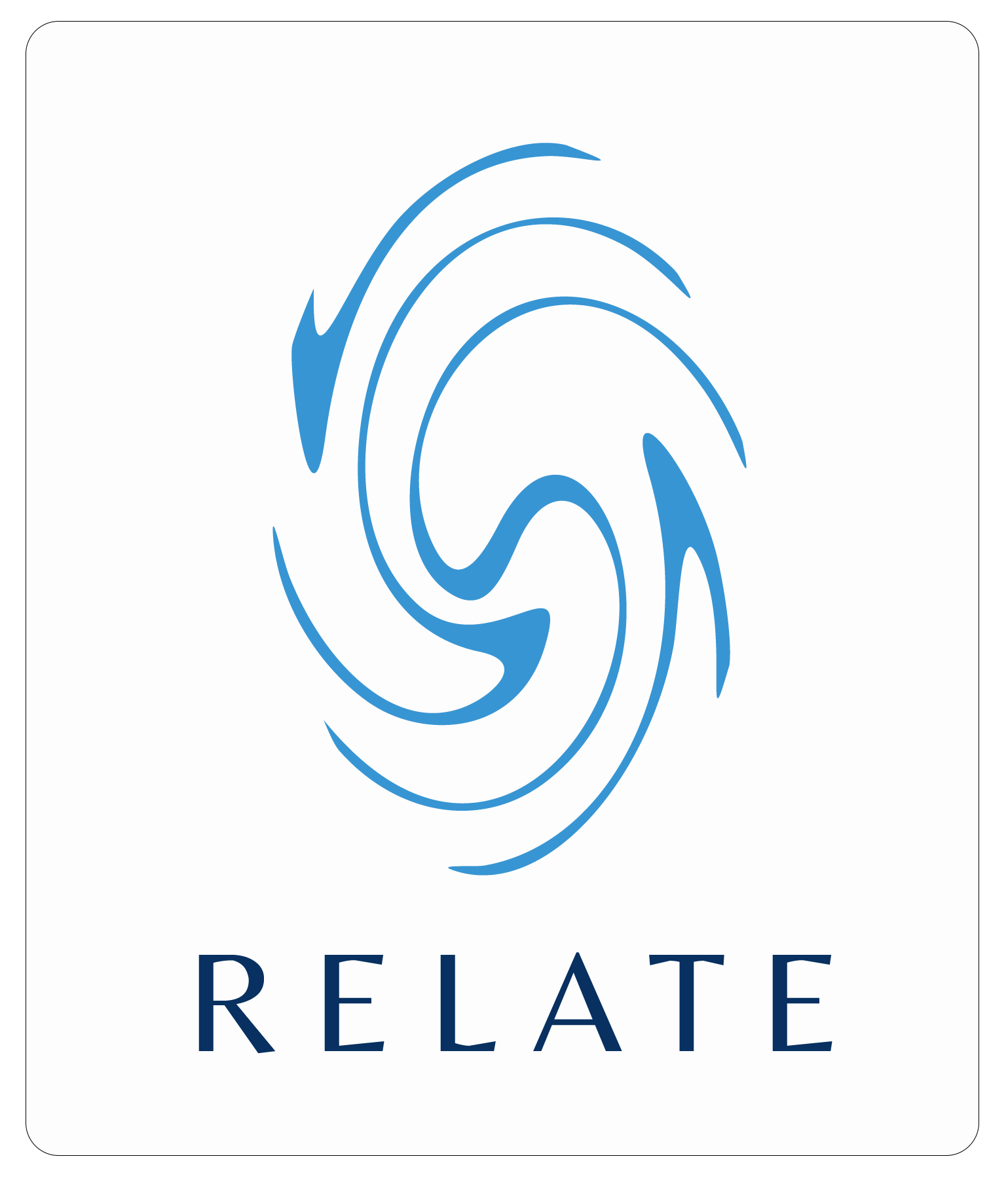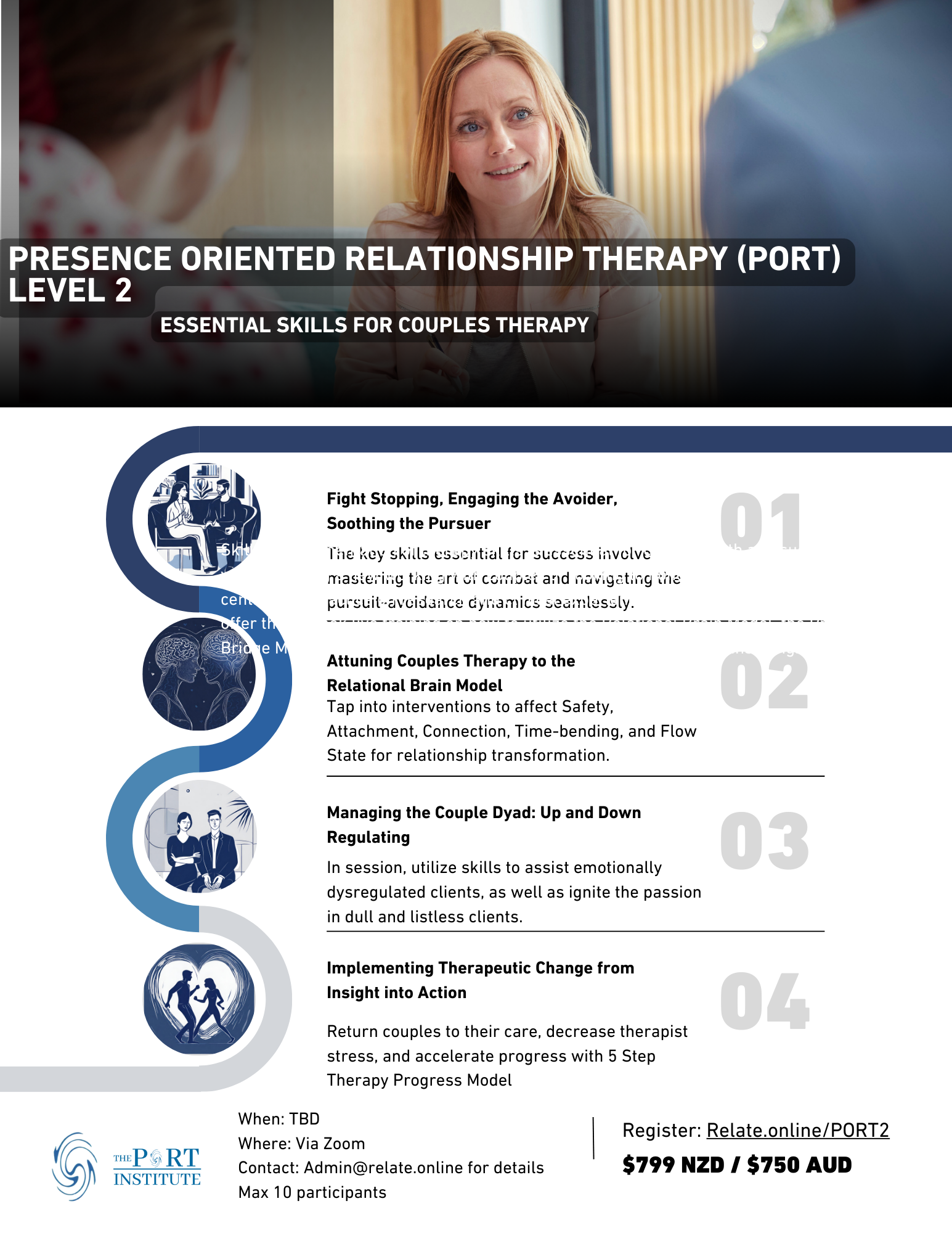
Integrated Couples Therapy: Presence Oriented Relationship Therapy (PORT) Level 1
Presence Oriented Relationship Therapy is an integrated approach to couples therapy designed specifically to for therapists starting to work with couples for the first time and more experienced therapists looking to integrate other models.
This gives therapists lifetime access to the PORT Level 1 Training and includes the cost for examination for PORT Level 1.
This training is PORT Level 1 and is focused upon the history of couples therapy and the 3 foundational theories of PORT: the Relational Brain Model, the Presence Bridge Model, and the 5 Step Therapy Progress Model.
- - - - - - - - - - - - - - - - - - - - - - - - - - - -
PORT is an integrated eclectic approach developed over the last 8 years by the Relate NZ team. Initially developed in the context of the weekly team training sessions it was honed over the next 6 years of the intern programme to help distill the core insights of successful couples and relationship therapy to clinicians who had not been specifically trained to work with couples.
PORT is an intensely practical course that coalesce around the challenge of finding the successful common features of therapy models as diverse as PACT, EFT, Imago, Gottman and the Developmental Model. What became clear is that each of these models offered significant strengths but often lacked essential features or flexibilities present in other model. In addition insights from other modalities including Narrative, ACT, NLP, Psychodrama, Gestalt, Relational Neurobiology were incorporated.
Port's focus was simple and driven by the clear imperative of research that indicated that untrained therapist's working with couples were highly unsucessful and the therapy process itself was highly stressful for the couple and the therapist.
The challenge of course is that everyone needs to start somewhere and our focus was to support our interns to be successful as soon as possible.
While Steven was cross-training in Imago, Gottman and EFT he noticed a recurring pattern underlying their seemingly different methods. Steven adapted the Relational bridge model for interns to use and tested this among the team. The developmental brain model was the next innovation that made relational neuroscience accessible to clinicians and clients and therapy progress model among other innovations.
The feedback from PORT trained therapists is that they quickly felt confident to hold a relational space for the couple that felt safe for deep intimate connecting work and that they had strategies to help them contain and manage conflict. Additionally clinicians could maintain and develop their own unique authentic style and presence and incorporate other training and experience more seamlessly and effectively.
The online offering is designed to provide a resource and reference point for clinicians that can be assimilated at the therapists own pace and is designed to prepare therapists for PORT Level 2 which is 4 live sessions of group skills training with Steven which will give you provide opportunities for interaction and implementation.
You are suggested to subscribe to the Professional Edition of the School of Love to access psychoeducation materials which will make PORT easier to understand (specifically the 5 Secrets of Relationship Champions).
Where: Zoom
When: April 9, 16, 23, 30; May 7, 14, 21, & 28 at 11 AM - 1:30 NZST.
Continuing Education Details
Continuing Professional Education through the Australian Counselling Association: Approved for 10 OPD points.
Our CEs are hosted through EngagedMinds Continuing Education. EngagedMinds is a NY-S, NBCC, and ASWB approved provider.
Read our continuing education guide here.
Curriculum and Learning Objectives:
Integrated Couples Therapy Curriculum
Module 1: Introduction to Integrated Couples Therapy
-
Identify the 5 key principles of couples therapy
-
Explain the research that underpins couples therapy practice
-
Synthesize the Pursuer/Avoider Dynamic with Attachment Research
Module 2: What Breaks Relationships - The Pursuer/Avoider Dynamic
-
Identify how a couple’s behavior indicates their phase of the cycle of relationship
-
Describe the Pursuer/Avoider Dynamic and how it impacts a relationship
-
Employ interventions to engage both the pursuer and the avoider in therapy
Module 3: The Presence Bridge Model
-
Apply the Presence Bridge Model to a couples’ ability to connect with each other
-
Utilize scaffolding techniques to help couples improve their connection
-
Initiate interventions to help a couple deepen a dialogue to identify needs,
values, and longings
Module 4: The Relational Brain
-
Describe the Relational Brain Model
-
Assess the couple’s brain state in real time
-
Facilitate the couple’s behavior to engage effectively in different brain states and ultimately move into flow
Module 5: The 5 Step Therapy Progress Model
-
Describe the 5 Step Therapy Progress Model
-
Identify the goals and interventions of each stage
-
Devise formulations for a couple’s presenting concern
Module 6: Assessments and Formulations
-
Structure a couple’s therapy assessment
-
Administer strategies to create alliance and ultimately improve therapy outcomes
-
Identify how to utilize formulations as part of an assessment
Module 7: Dealing With Betrayal
-
Demonstrate the multi-level impacts of betrayal
-
Apply target interventions to address betrayal in real time
-
Distinguish appropriate interventions for addressing shame and personal
reactivity
Module 8: Interventions
-
Formulate interventions to strengthen the couple’s alliance and connection
-
Appraise the couples readiness for interventions based upon relationship
history, brain state and present interactions
-
Prioritize interventions based upon the couple’s goals and progress

This product is rated 5.0 of 5.0 stars.
It has received 3 reviews.





